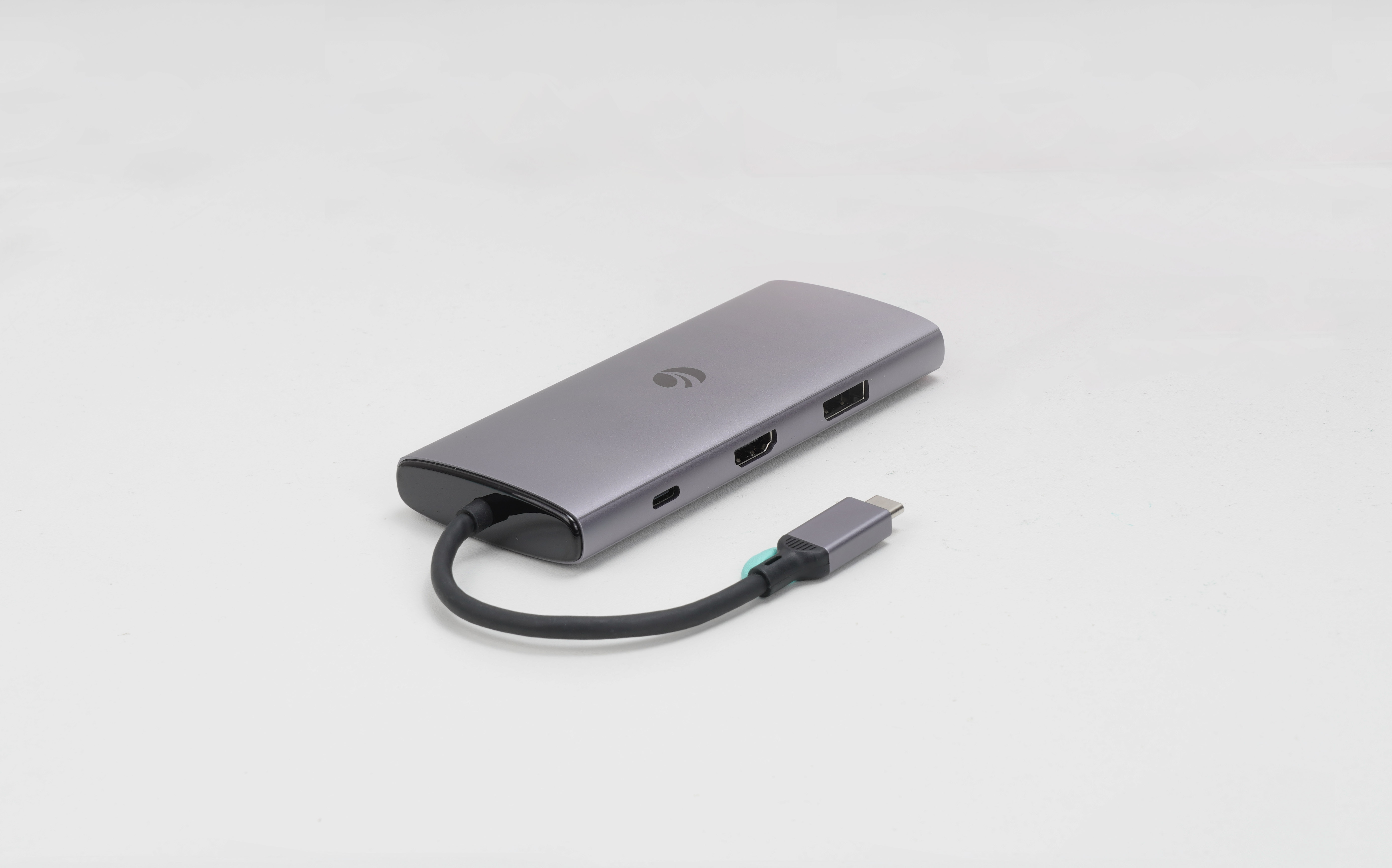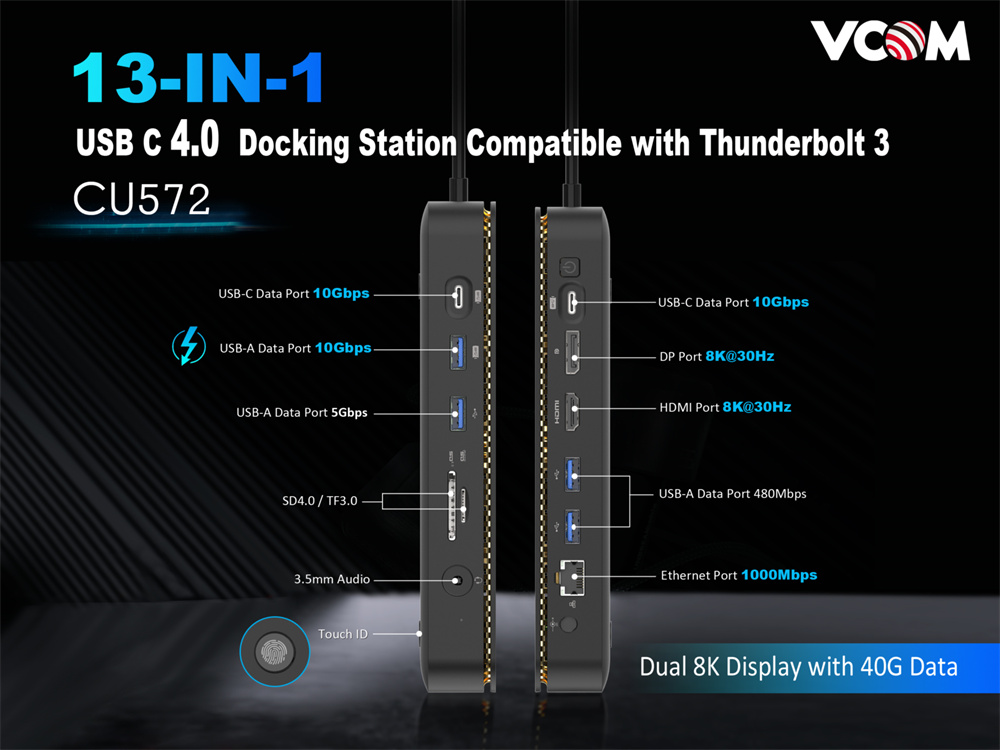Computers and laptops have become an indispensable tool in our daily life. In some scenarios, we need to connect multiple devices to a laptop, but most computers only have 1 or 2 ports, which is a troublesome problem.
In today's fast-paced digital age, versatility and connectivity are paramount. A docking station, often referred to as a hub, plays a crucial role in enhancing the functionality of our computers. Whether you're working from home, in an office, or on the go, a docking station can be a helper.
This article will delve into what a docking station does, how to set one up, and the myriad benefits it offers.

What Does a Docking Station Do?
Definition and Purpose
A docking station is an extension device for computers. It primarily extends the number of available ports, converting a single port into multiple ones. This allows users to connect various external devices simultaneously. For users whose computers have limited ports, this becomes indispensable. Docking stations cater to the need for additional ports to connect peripherals like headphones, microphones, keyboards, mice, data cables, and USB drives.
Types of Docking Stations
Docking stations come in various types, each suited to different needs:
USB Docking Stations: These are common for desktop computers. They connect via a standard USB port and typically provide multiple USB outputs. They are generally affordable and easy to use, making them a popular choice for many users.
Type-C Docking Stations: With the rise of USB Type-C ports, these docking stations are becoming more popular, especially with laptops. They offer higher data transfer rates and better compatibility with a wide range of devices. Type-C docking stations often support additional features such as charging capabilities and video output.
Functionalities and Features
Docking stations vary in their functionalities:
Basic Models: These primarily expand the number of USB ports. They are ideal for users who need to connect multiple USB devices like flash drives, external hard drives, and keyboards.
Advanced Models: These offer a range of additional features, including HDMI for high-definition displays, Power Delivery (PD) for fast charging, VGA for older monitors, SD/TF card readers, and 3.5mm headphone jacks. Advanced models can transform a laptop into a powerful workstation, supporting dual monitors, high-speed internet connections, and more.
How to Set Up a Docking Station
1. Initial Setup
Setting up a docking station is straightforward but requires some initial steps:
Identify Device Compatibility: Ensure that the docking station matches your computer's primary interface, whether it's USB or Type-C. Compatibility is crucial to ensure all features of the docking station work seamlessly with your device.
Check Functional Requirements: Determine your needed functionalities, such as additional USB ports, HDMI, Ethernet, etc. Make a list of all the peripherals you plan to connect to ensure the docking station meets your needs.
2. Connection Process
Once you've selected the right docking station, follow these steps to set it up:
Connect Docking Station to Your Computer: You need to use the designated port (USB or Type-C). Ensure the connection is secure and the docking station is placed in a convenient location on your desk.
Install Drivers if Necessary: Some products may require driver installation for full functionality. Follow the docking manufacturer's instructions to install any required software.
Connect External Devices: Attach peripherals like monitors, keyboards, mice, and external storage to the docking station. Ensure all devices are properly connected and powered on.
3. Testing and Troubleshooting
After setup, ensure everything works correctly:
Verify Connections: Ensure the computer recognizes all connected devices. Check the device manager or system preferences to confirm all peripherals are listed.
Troubleshoot Issues: If there are connectivity issues, check the cables, update drivers, or restart the computer. Refer to the docking station's manual for specific troubleshooting steps.
4. Maintenance
To keep your docking station in optimal condition:
Regular Updates: Keep the firmware and drivers updated. Manufacturers often release updates to improve performance and add new features.
Cable Management: Organize cables to avoid clutter and potential damage. Use cable ties or organizers to keep your workspace tidy and prevent tangling.
Benefits of Using a Docking Station
Productivity Enhancement
A docking station simplifies the connection process, allowing you to seamlessly switch between different setups. This can significantly enhance productivity by reducing the time spent connecting and disconnecting devices. For example, a single connection to the docking station can instantly link your laptop to multiple monitors, a full-sized keyboard, a mouse, and other peripherals.
Port Protection
Frequent plugging and unplugging can wear out your computer's ports. A docking station mitigates this by providing a single point of connection, thereby extending the lifespan of your computer's ports. This is particularly important for laptops with limited port availability.
Expanded Functionality
Modern laptops, especially ultra-thin models, often lack sufficient ports. A docking station compensates for this limitation, providing access to additional ports and features that are not available on your computer. This can include Ethernet ports for wired internet connections, HDMI or DisplayPort for external monitors, and multiple USB ports for various peripherals.
Choosing the Right Docking Station
Compatibility
Ensure that the docking station is compatible with your computer's primary interface. USB and Type-C are the most common, so choose accordingly. Compatibility also extends to the operating system, so verify if the docking station supports Windows, macOS, or Linux as needed.
Required Features
Determine which features you need. If you require multiple USB ports, HDMI for an external monitor, Ethernet for wired internet, or SD card readers, make sure the docking station offers these functionalities. Consider your future needs as well to ensure the docking station can accommodate any new peripherals you might acquire.
Brand and Quality
Select a reliable brand known for quality products. Check reviews and user feedback to ensure you're making a wise investment. Brands like Dell, HP, Lenovo, and Anker are well-regarded for their docking stations. Look for warranties and customer support options as well.

User Experiences
Many users have shared positive experiences with docking stations. They highlight the convenience of having all their peripherals connected through a single device and the enhanced productivity it brings. For instance, a graphic designer might praise a docking station for allowing them to connect multiple high-resolution monitors and a graphics tablet simultaneously.
Programmers often juggle multiple tasks, from writing code and debugging to collaborating with team members and testing software. Efficiency is key in such a demanding environment. A docking station can significantly enhance a programmer's workflow.
FAQs of Docking Station
Q1: Can I use a docking station with any laptop?
A1: Most docking stations are compatible with a wide range of laptops, but it's essential to check compatibility with your specific model. Refer to the manufacturer's specifications to ensure compatibility.
Q2: Do docking stations require power?
A2: Some advanced docking stations require external power to support additional functionalities, but basic models typically draw power from the connected computer. Always check the power requirements before purchasing.
Q3: Can a docking station improve my laptop's performance?
A3: While a docking station doesn't directly enhance performance, it can improve productivity by providing additional ports and simplifying device connections. It can also help maintain performance by reducing port wear and tear.
Q4: Are there any security risks with using docking stations?
A4: Generally, docking stations are safe to use. However, always ensure you're using a reputable brand like VCOM to avoid potential security vulnerabilities. Be cautious when connecting devices to unknown docking stations, especially in public places.
Here are some recommended articles related to "Docking Station" that you may be interested in.
Why Does the Docking Station Get Hot?
The Differences Between USB C HUB and USB C DOCKING
Tag:




